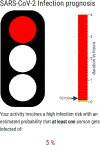Empowering Communities: Tailored Pandemic Data Visualization for Varied Tasks and Users
- PMID: 40227911
- PMCID: PMC12075951
- DOI: 10.1109/MCG.2024.3509293
Empowering Communities: Tailored Pandemic Data Visualization for Varied Tasks and Users
Abstract
Data visualization methodologies were intensively leveraged during the COVID-19 pandemic. We review our design experience working on a set of interdisciplinary COVID-19 pandemic projects. We describe the challenges we met in these projects, characterize the respective user communities, the goals and tasks we supported, and the data types and visual media we worked with. Furthermore, we instantiate these characterizations in a series of case studies. Finally, we describe the visual analysis lessons we learned, considering future pandemics.
Figures






Similar articles
-
Reflections on the Use of Dashboards in the COVID-19 Pandemic.IEEE Comput Graph Appl. 2025 Mar-Apr;45(2):135-142. doi: 10.1109/MCG.2025.3538257. IEEE Comput Graph Appl. 2025. PMID: 40504737
-
Measures implemented in the school setting to contain the COVID-19 pandemic.Cochrane Database Syst Rev. 2022 Jan 17;1(1):CD015029. doi: 10.1002/14651858.CD015029. Cochrane Database Syst Rev. 2022. Update in: Cochrane Database Syst Rev. 2024 May 2;5:CD015029. doi: 10.1002/14651858.CD015029.pub2. PMID: 35037252 Free PMC article. Updated.
-
Antibody tests for identification of current and past infection with SARS-CoV-2.Cochrane Database Syst Rev. 2022 Nov 17;11(11):CD013652. doi: 10.1002/14651858.CD013652.pub2. Cochrane Database Syst Rev. 2022. PMID: 36394900 Free PMC article.
-
Physical interventions to interrupt or reduce the spread of respiratory viruses.Cochrane Database Syst Rev. 2023 Jan 30;1(1):CD006207. doi: 10.1002/14651858.CD006207.pub6. Cochrane Database Syst Rev. 2023. PMID: 36715243 Free PMC article.
-
Unintended consequences of measures implemented in the school setting to contain the COVID-19 pandemic: a scoping review.Cochrane Database Syst Rev. 2024 Dec 12;12(12):CD015397. doi: 10.1002/14651858.CD015397.pub2. Cochrane Database Syst Rev. 2024. PMID: 39665337
References
-
- Wentzel A et al. “MOTIV: Visual exploration of moral framing in social media,” Comput. Graphics Forum, vol. 43, 2024, Art. no. e15072.
-
- Baumgartl T et al. “In search of patient zero: Visual analytics of pathogen transmission pathways in hospitals,” IEEE Trans. Vis. Comput. Graphics, vol. 27, no. 2, pp. 711–721, Feb. 2021. - PubMed
-
- Sondag M, Turkay C, Xu K, Matthews L, Mohr S, and Archambault D, “Visual analytics of contact tracing policy simulations during an emergency response,” Comput. Graphics Forum, vol. 41, pp. 29–41, 2022.
Publication types
MeSH terms
Grants and funding
LinkOut - more resources
Full Text Sources
Medical
Miscellaneous

